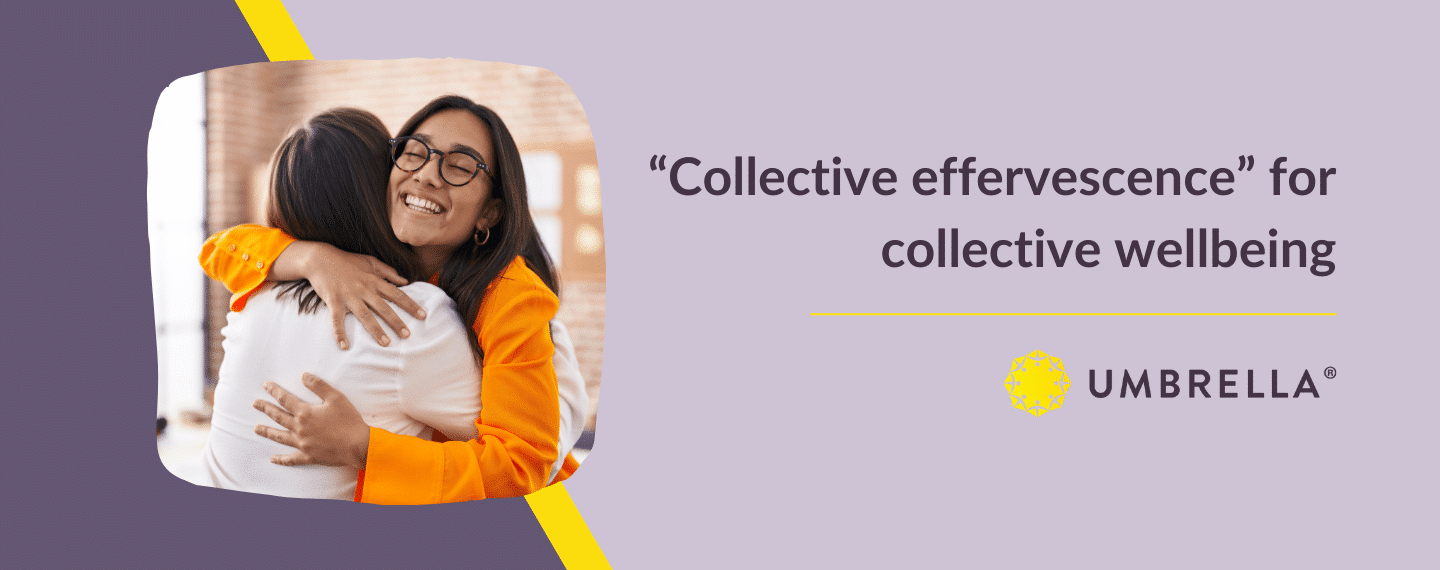As we write this, the holiday season is upon us. These are our tips for getting the best out of time spent with others. But the truth is, these insights will serve you well all year round.
Let’s start with a term coined by sociologist Emile Durkheim more than 100 years ago: collective effervescence.
Durkheim proposed that when we come together, and when we share emotions and behaviours, we experience a kind of shared “sparkle”. It takes the dull edge off difficult times, and it creates stronger bonds and stronger wellbeing. Just like the definition of “effervescence” itself, there is a fizz, liveliness and energy that emerges when we feel, and do stuff, together.
The most obvious example of this is when we are in a big crowd of people – cheering on our favourite sports team or singing along to live music, for example. But research has shown that even the most everyday experiences can create effervescence, like sharing frustration with a stranger over the queue at the supermarket, or watching a gripping TV show with other people.
When we share experiences together, especially experiences that include some sort of shared behaviour and emotion, we connect better with one another and we feel better. This is aligned with a new line of research that emphasises the power of focusing on collective, rather than individual, wellbeing. It’s a particularly powerful call to action in a world that feels increasingly disconnected, with loneliness on the rise. When we prioritise experiences that bring us all together, especially as crowds or communities, we tap into a key ingredient of what it means to be human.
Whether you have a long holiday break ahead of you or you’re working all the way through summer, whether you have treasured people to spend the holidays with or you’re dreading the complicated social dynamics, here are three steps for building collective effervescence as a path to collective wellbeing.
Step 1: Be with people
The essential element of collective effervescence, and the energy that comes with it, is making the space to be together, or to simply be around other people.
If you’re lucky enough to live near the people you love, schedule intentional time all together. Then follow steps 2 and 3.
If you can’t be with the people you love, or you’re being pulled into engagements with people you don’t know very well, that’s OK. Let’s say you’ve just started a new job and you’re a bit iffy about your new colleagues, you’re being forced to spend the holidays with the in-laws against your will, or you’ve been invited along to a community event full of strangers. Whatever the situation, try to embrace the opportunity with an open mind. Collective effervescence is only possible when you create space to be with other people, and the wellbeing benefits are worth it.
Finally, if you’re feeling disconnected this holiday season, or you could do with an extra wellbeing boost, try to be intentional about being around other people, even if informally. Consider visiting your local shops instead of shopping online or spend an afternoon walking around a nature reserve where there are other people. Moments of collective effervescence thrive among strangers if you are open to the opportunity.
Step 2: Share in positivity
Once you’ve created space to be together with, or around, other people, scan for opportunities to boost positive emotion together. These don’t need to be corny or cheesy. Maybe you smile at someone on the footpath when your dogs stop to greet each other, or compliment someone on the train.
At work, especially as you hold end-of-year events, focus on creating attentional, behavioural and emotional coordination to maximise collective effervescence. That means bringing people to the same physical or online space, doing something altogether, and soaking in what’s good (e.g., celebrating the successes of the year).
The same principles apply for our home lives. Whether you’re with family, friends, or otherwise this holiday season, do you have some collective rituals that you can participate in to tap into that collective effervescent sparkle? Common ones include decorating holiday ornaments, listening to holiday music, unwrapping gifts, or eating special meals. Try to maximise the togetherness – and the positive emotion – whatever it is you do.
Step 3. Share in discomfort
Finally, Durkheim was explicit in his early theories that collective effervescence is not reserved for positive emotions. We benefit from the energy that comes from a group coming together to grieve, to challenge, and to process. This year, like any, has had its own challenges.
At work, many of us have lived through restructures and redundancies. To build collective effervescence while honouring the year that has been, consider taking a moment during your end-of-year events to acknowledge the difficulties of the year, raise a glass to the tough times, or share some memories of the journey.
At home, take the time to honour any family members or friends who have passed away in the year previous, or those who are struggling with something. Research shows that reliving good memories through reminiscing is a helpful tool for building collective effervescence, and other research talks about the power of group rituals for grieving.
And, if you are struggling with the political climate, or things in your community that you would like to change, consider bringing friends and family together to volunteer or campaign for issues that you all care about.
Need help improving the collective wellbeing of your team? Umbrella workshops are delivered by experienced psychologists and designed to create opportunities to strengthen team bonds, share in emotions and tackle wellbeing goals collectively. Get in touch with us to see how we can help you to finish the year, or start the new year, with a dose of collective effervescence.



